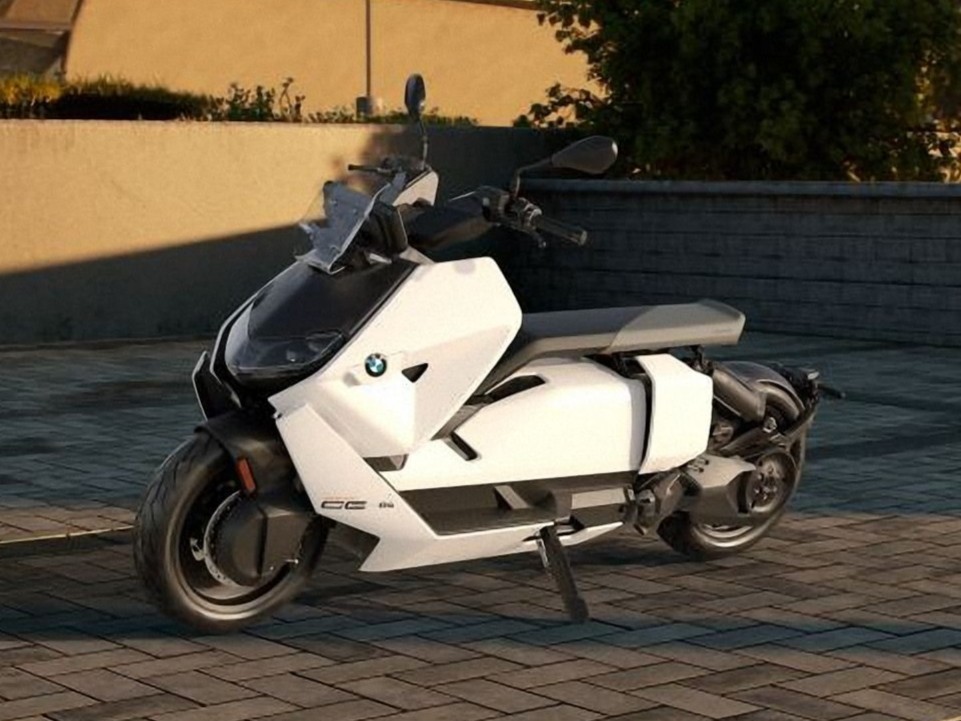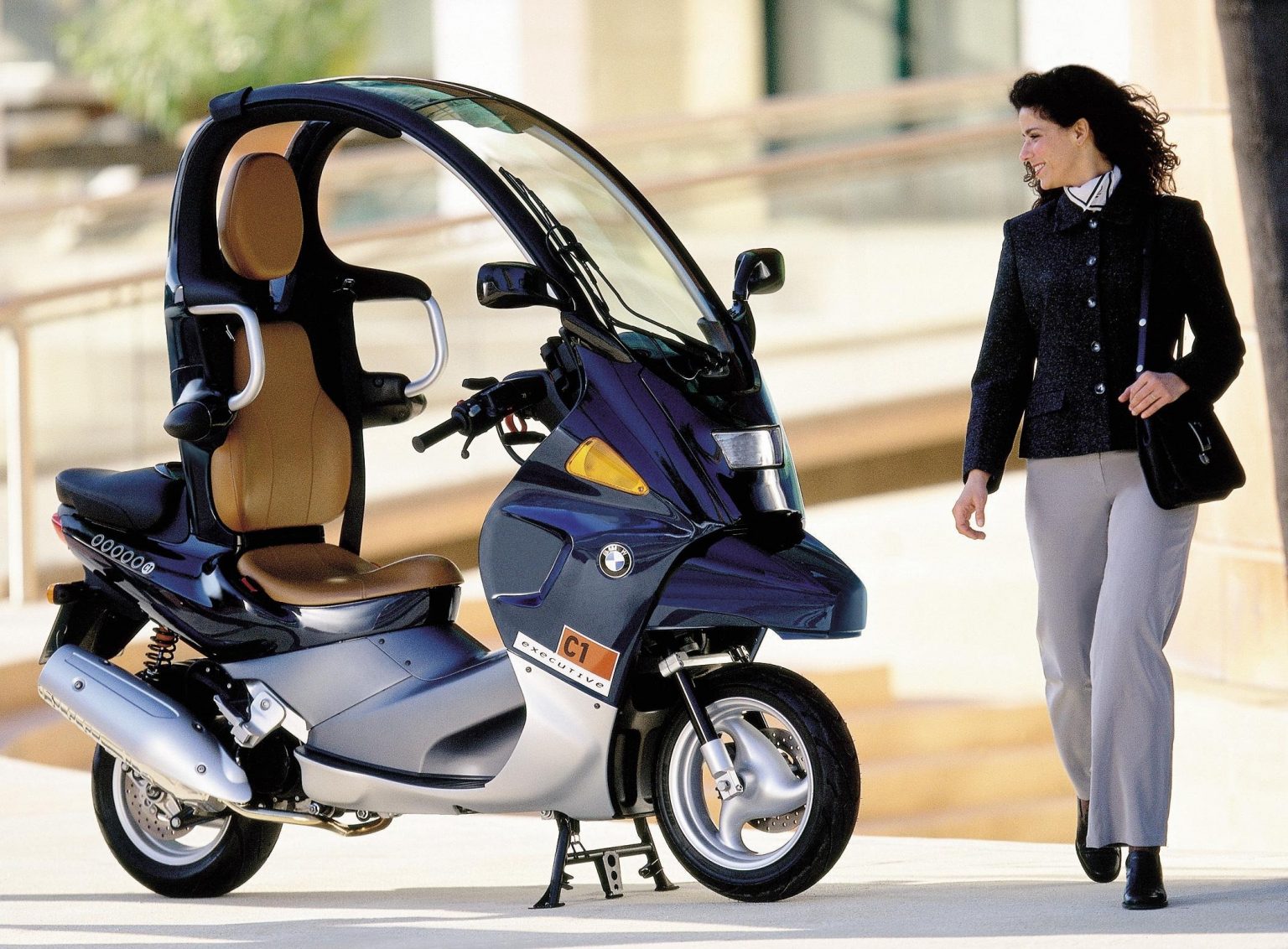The subject of protective gear is a huge one in motorcyclist communities. A lot of riders live by the mantra ‘All The Gear, All The Time‘ (also known as ATGATT), while others hit the road in little more than sandals, shorts, and a tank top. Good gear saves lives, but what if you didn’t have to wear gear at all? BMW has unveiled a crazy concept scooter that explores this very idea. This is the BMW Motorrad Vision CE, and it’s BMW’s vision for a future scooter that provides a “carefree riding experience.”
Believe it or not, the vehicle on your screen today is not the result of an unfortunate scooter crash into some scaffolding. Don’t check your calendars, either, because it’s not March 32nd. BMW Motorrad presented the Vision CE at the IAA Mobility 2025 motor show, and, reading the press copy, BMW is quite serious about this idea of a motorcycle that’s so safe that you don’t need to wear protective gear.
It’s an interesting idea, too. As of this year, the Governors Highway Safety Association claims, only 17 states plus Washington D.C. require all motorcycle and scooter riders to wear helmets, though a total of 47 states have some sort of helmet law for certain riders. Three states, including my current home state of Illinois, have no helmet law. In many jurisdictions, this means putting on a helmet and, ideally, putting on a protective jacket and gloves, even if you’re just going on a slow ride in a dense city. According to the Centers for Disease Control and Prevention, motorcycle helmets are 37 percent effective at preventing rider deaths and 69 percent effective at reducing the risk of head trauma. If you ride, you absolutely should wear a helmet at the very least.

But what if you didn’t need to? What if your motorcycle could protect you in a crash like your car could?
A Scooter With Crumple Zones
BMW Motorrad has been getting weird and cute with scooters in recent years. The company, which is perhaps known best by Americans for its GS adventure bike series, started producing the BMW CE 04 in 2022. The all-electric scooter looks like something out of a video game set 50 years in the future and has a max power of 42 HP, a max speed of 75 mph, and a range of 80 miles. Sure, it costs a huge $12,195, but it looks like no other scooter ever built before or after.

In 2024, BMW launched the CE 02, a lower-buck urban bike with 15 HP, a top speed of 59 mph, and 56 miles of range for $7,599. Back in 2022, BMW Motorrad said that it had planned on introducing a new bike every 18 to 24 months, and it has pretty much lived up to the promise. BMW has been working on electric motorcycle development for close to 15 years, too. So, while the Vision CE is pretty far out, it is on-brand for BMW, which has been getting properly weird with its two-wheelers lately.
This scooter is a spiritual successor to the last time BMW tried to make a sort of safety motorcycle. We’ll get to that in a moment.

BMW Motorrad’s press release is short and to the point, and says that the centerpiece of the BMW Motorrad Vision CE is its “metal tube composite” safety cage. BMW says that this crash structure, in conjunction with a reinforced seat and a seatbelt, gives the rider enough safety that, if they were to crash, they wouldn’t need to wear a helmet or any protective gear to walk away from a crash.
The idea here is that an urban rider can enjoy the best of both worlds. They can experience the thrill of riding a two-wheeler with the same ease with which they would drive a car. BMW sees this concept working best in a city, where speeds are lower and where people might want to ride a scooter type of vehicle for commuting or just getting around.

Additional technology meant to make riding even easier includes a self-balancing system and maxi-scooter-like floorboards. That balancing system, BMW says, would keep the scooter sitting entirely upright when sitting at a stop.
Mechanically, the Vision CE is closely related to the aforementioned CE 04. Of course, the Vision CE is going to be heavier, but having up to 42 horsepower on tap and an 80-mile range would make this a fairly competent city ride. Conversely, as I explained earlier, the CE 04 is not cheap, and I don’t see this being any more affordable.

I also question the premise. Sure, the scooter might have a cage and all, but there’s still a giant hole above where your head goes, and those metal bars are quite narrow. If your head falls outside of the cage, I don’t see how the cage will protect you. Likewise, BMW’s renders show digital people riding these things with their arms outside of the cage, which means they probably wouldn’t do so hot in a crash, either.
Finally, the press copy spends so much time talking about the crash structure, but what about your legs and feet? Your lower extremities are very likely to get banged up in a crash, and BMW doesn’t mention any safety measures in that regard.
Not BMW’s First Rodeo

Weirdly, this isn’t the first time BMW has designed something like this. Back in 2000, BMW actually put a safety scooter into production. Here’s what I wrote in 2023:
In 1992, BMW rolled into the Cologne, Germany motorcycle show with what it called the C1 Concept. This vehicle wasn’t quite a motorcycle, but it wasn’t really a scooter either.
[…]
BMW’s conclusion was that while cars will be necessary for mobility, cars cannot meet all mobility demands, especially in densely populated areas. Those are ambitious plans. The C1 Concept (above) was supposed to be a motorcycle that was as safe as a city car but with the space savings and thrill of a motorcycle, and all for a price so cheap that its monthly payments would be lower than a train pass.
As BMW notes, the project for the C1 started two years before with a contest in subsidiary BMW Technik GmbH. Bernd Nurtsch, an avid motorcyclist, paid attention to motorcycle crash statistics, especially honing in on the crashes he and his friends had survived. This compelled Nurtsch to submit the idea for a new kind of scooter. This scooter would protect its occupants with a safety cell, crumple zone, and seatbelts so that helmets weren’t needed.
I wasn’t exaggerating about the helmet thing, either. BMW says it went pretty hard into safety:
Detlef Helm, at the time the specialist at BMW Technik GmbH for complicated calculations, made a significant contribution to the ensuing feasibility study by his special computation model examining a frame support structure made of pressed aluminium profiles. Providing a kind of safety cell to protect the occupant, this structure with its special longitudinal and transverse stiffness was to be combined with additional deformation elements for the controlled absorption of energy, protecting the driver in a collision with a stationery or mobile object at a speed of up to 50 km/h just about the same way as in a car. And in a collision from the side this configuration was also to give the driver much better protection than on a motorcycle.
The production BMW C1 had an aluminum spaceframe, crumple zones, a rollbar, and a seatbelt. Amazingly, in 1998, both the German Federal Ministry of Transport and the German TÜV Technical Inspection Authority approved the C1’s use without an otherwise mandatory helmet. BMW was so proud of what it achieved with the C1 that marketing materials displayed the scooters being ridden by people who weren’t wearing any gear.

The BMW C1 had some genuine innovations, but looked cooler on paper than it worked in real life. Here’s a snippet from the review that was published in Business A.M., emphasis mine:
How does one refer to the C1? The newer and larger C1 200 certainly does not feel like a motorcycle, despite its 170cc engine and the fact that you need a full bike licence to ride it. With its big, comfy, car-like seat you can sit back, almost put your feet up, and enjoy the ride. It is a twist ‘n’ go like a scooter, but how many scooters have an interior light, a roof, windscreen and wiper, a glovebox, and seatbelts? But something tells me it is not a car…
Maybe it is the car for motorcyclists, or the scooter for car drivers. Whatever it is, this caped crusader of a vehicle attracts a lot of attention wherever you go and is brilliant fun to ride, especially if you don’t mind people laughing, staring, smiling, waving and pointing at you. In the end, you just smile and wave back.
Ironically, it was the roof of the C1 that was to be the undoing of my brief but mostly pleasurable relationship with this strange machine. Turning tightly to position myself at a set of traffic lights, I lost my balance – and dropped it. Unfortunately, the C1’s biggest “safety” feature sandwiched my hand between it and an ambulance, so I am now nursing a broken wrist and a bruised ego.
Ultimately, BMW sold the C1 for only a couple of years, moving only 12,614 copies in that time. The C1 failed to live up to the promise of having cheaper monthly payments and operating expenses than the cost of a monthly train pass, and places like Sweden and the UK did not allow C1 riders to scoot around without helmets.

At least from my eyes, the BMW Vision CE might cure the C1’s old problem of not being able to balance itself, but it would seem to me that you would still want to wear a helmet and gear while riding it. Motorcycle crashes are serious, and crumple zone or not, you will want to be as safe as possible.
But perhaps my concerns are unwarranted for now. BMW says that the Vision CE is just a concept and, at least for now, there are no plans for production.
Still, this thing is properly weird and ridiculous. Motorcycle companies seem to love this idea of bringing car safety tech to motorcycles and scooters, and the results are always strange. So, props to BMW for getting my attention and for making a wild concept. But, should anything like this ever enter production, I’d probably still wear my gear when riding it.
Top graphic image: BMW








This design works well for a scooter, but even better for a shoulder grater.
Cannot imagine the mess asphalt would make on anyone falling while strap to one of these
I absolutely love it, and want one. Like, today.
they need to go back to C1 style when it comes to the cockpit
the scafholding is just a bait for people to hang things from it and create more danger along the way.
I can envision some fool strapping camping gear on the scaffolding. Center of gravity, anyone?
I hate all of this, sorry, I can’t even read your article Mercedes, the AI picture of Ms. Checkingherphone with the random unleashed “dogs” broke me.
The dogs were a seriously odd choice
Right?
OK, still wearing helmet and bike wear with it.
But, looking at it as a bike i quite like it, plenty of options on that cage for extra storage out back if the self stabilising kit could handle it. Scooter adventure bike?
Reigniting the legislation v.s. Darwin debate.
I think I’d be more interested in something like a Can-Am Spyder with weather protection and a roll cage. That might be easier to make safer and could be designed to be efficient. Might make a good year- round commuter.
I don’t think this was all that successful the last time BMW did it.
It’s cool, but like, just buy a car at this point.
It looks like a Honda Ruckus with a freak mutation.
This is not a bad thing.
They’d be better off just including an integrated means of locking up the helmet so the user doesn’t have to carry it around when they get there.
Detlef Helm (Helm = helmet in German) simply had to be the specialist to do the calculations here.
As someone who worked in grocery with (at various times) a meat manager named Mike Bacon and a refrigeration mechanic named Bob Frost, I heartily agree.
I once went through the McDonald’s walk-through line at the Minneapolis Airport (Between terminal F and terminal G) and the on-duty manager’s last name was Bergermaker. (according to the sign)
That’s gonna be a no from me.
I’m sure this has all been figured out by BMW with belts and restraints, but traditionally cages don’t like heads if they come together. Keeping the helmet on in a car on the return road or in a transit section has been proven wise more than once.
Being a “cager” with only two wheels is quite an accomplishment.
Coming from a well strapped in car to being perched on a motorcycle can feel strange for a second for myself maybe a moment of unease, I consider that part of the experience. Obviously a designer at BMW has dreams of engineering that away, again.
If it reaches production potential buyers will vote nope all over again.
Having been sideswiped with just seconds to see it coming, I’m glad I wasn’t strapped on. Jumping off before impact saved me a whole lot of hurt. I don’t think I would like to be strapped into/onto a two wheeled vehicle. At least it’s not gas powered, so you’d be less likely to be pinned under a burning bike.
Yeah, generally speaking in a two wheel crash you want to separate from the bike ASAP. A lot of injuries happen due to get pinned or hit while tumbling.
I would for sure still ware a helmet. Also, those bars should have airbags in them.
Yeah there is no way dropping this thing wouldn’t result in your brain bone getting rickety-rocked against both the crash bar and pavement. You’re safer with real crash bars on the side of the bike.
There is also no roof on the modern one so it’s 100% pointless.
And where am I supposed to keep the three poodle puppies? Under the seat?
I’d trade all of that up-high weight for just wearing a brain bucket.
I could see using the cage as mounting points for some rudimentary weather protection, perhaps clear vinyl, that could extend the riding season.
That’s how the C1 worked! I’m sort of impressed that the concept that’s 25 years newer technically has fewer protections.
Edit: TL;DR moment.
It looks neat but all your concerns are warranted, Mercedes. If you don’t want to wear gear and be safe(r) in a crash, drive a car.